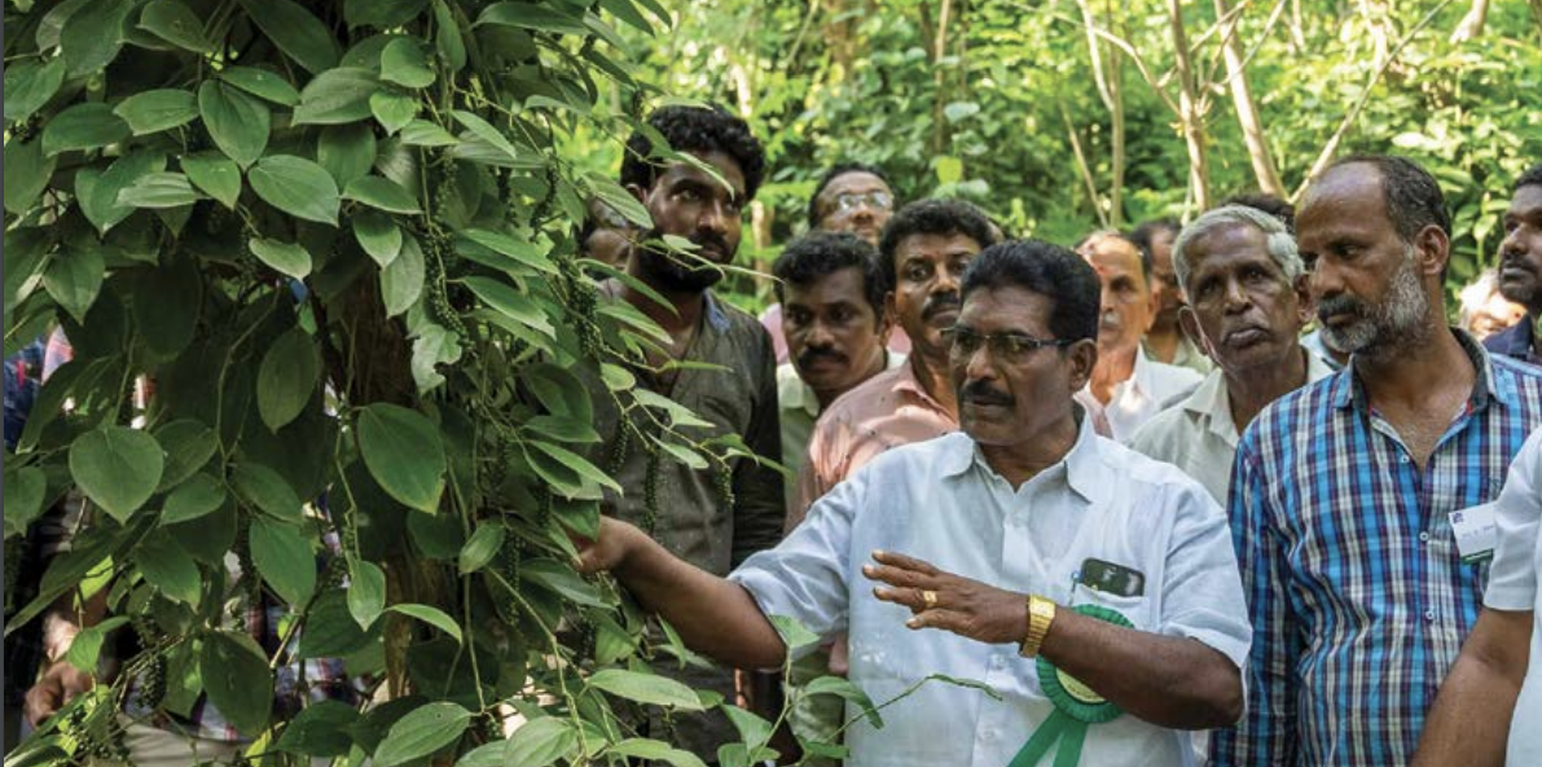



The Save Soil Farmer Training and Handholding approach seeks to combat soil degradation by promoting practices that increase soil organic matter content to 3% or above. The objectives include enhancing soil health through boosting organic matter, which improves underground water storage, green cover, biodiversity, and food security. By integrating traditional knowledge with modern techniques, this approach aims to restore soil health through simple, adaptable methods such as tree-based agriculture (agroforestry), organic mulching, crop rotation, cover cropping, and using natural composts that increase soil organic matter while minimizing disturbance. The approach focuses on marrying ecology with economy, ensuring that regenerative practices are both economically and environmentally viable.
Widespread implementation begins with awareness and advocacy, followed by training programs for farmers and support for adopting regenerative agricultural practices. Initially, farmers were sceptical due to the time required for soil regeneration compared to simply adding synthetic inputs. However, the long-term benefits—such as improved soil health, stable yields, and reduced reliance on chemical fertilizers—have led to increased acceptance. Over the past 20 years, this approach has transformed agriculture in Tamil Nadu, focusing on farm economics and agroecology. Training, support, and resources have been offered to help farmers adopt regenerative agriculture for major crops in the region.
The strategy of the approach is to start with medium-sized landholders first, who can take risks and later serve as volunteer trainers. This "raindrop model" spreads knowledge effectively, empowering farmers to educate others, which builds trust and accelerates adoption. Farmers receive training in crop management, livestock care, efficient water use, and pest control, while model farms serve as educational hubs showcasing regenerative techniques.
Over 45,000 farmers have been trained in regenerative farming techniques, 400+ WhatsApp groups linking 88,000 farmers have been formed, and thousands of consultations provided through helplines. A vibrant community now exists comprised of over 250 lead farmers driving natural farming adoption across Tamil Nadu. A dedicated team of 160 field executives conducted 33,000 individual on-farm consultations in 2023, providing personalised support to farmers, including soil and water testing and recommending regionally-appropriate tree varieties. Production and distribution of high-quality organic saplings to participating farmers at a nominal cost encouraged greater participation. 229,000 farmers across Karnataka and Tamil Nadu have transitioned to tree-based agriculture, with 116 million saplings enabled by farmers and community participation. Women's empowerment is emphasized, with many nurseries operated by women, contributing to their economic upliftment and community involvement.
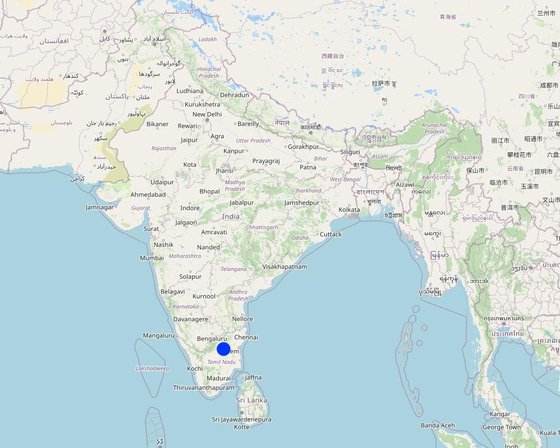
地点: Tamil Nadu and Karnataka, 印度
启动日期: 2007
终止年份: 不适用
方法的类型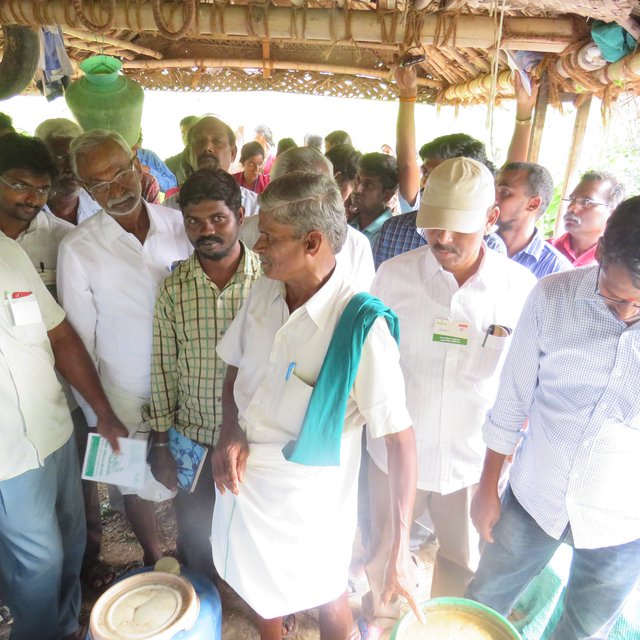
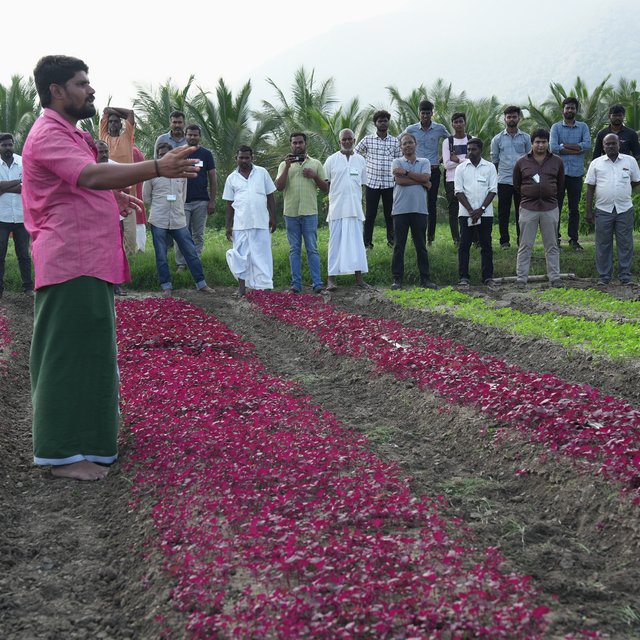
| 该方法涉及哪些利益相关者/执行机构? | 指定利益相关者 | 说明利益相关者的角色 |
| 当地土地使用者/当地社区 | Local farmers and community members are the primary implementers of sustainable practices. | They adopt the regenerative techniques promoted by Save Soil and actively contribute to the success of the approach by sharing their experiences and inspiring others. |
| SLM专家/农业顾问 | SLM specialists and agricultural advisers provide technical guidance and training to local farmers. | They help ensure that the recommended practices are effectively implemented and tailored to local conditions. |
| 研究人员 | Researchers contribute by conducting studies to assess the impact of sustainable practices on soil health, crop yields, and ecosystem resilience. | They also help in refining and improving the techniques used. |
| 教师/学龄儿童/学生 | Teachers and students play an important role in spreading awareness. | Schools organise educational programs and activities that introduce the younger generation to the importance of soil health and sustainable agriculture in our model farms. |
| 私营部门 | The private sector contributes by providing resources, such as inputs and funding, and by creating market linkages for sustainably produced goods. | Their involvement helps to build an ecosystem that supports natural farming practices. |
| 地方政府 | Local government bodies | They assist in creating a conducive environment for implementing sustainable practices by supporting community initiatives and providing local-level policy support. |
| 国家政府(规划者、决策者) | The national government plays a key role in policy formulation and advocacy. | Planners and decision-makers work to integrate regenerative agriculture into national policies, which helps in scaling the movement. |
The Training and Awareness team designs annual training plans, with farmers enrolling via WhatsApp team ads, based on content from the Content Creation team. After training, farmers are encouraged to join a WhatsApp group for updates. For technical queries, farmers contact the 12x7 helpline, and the Call Center Team records and analyses the issues with the central team to provide the necessary assistance. If an issue requires a Field Visit, the Field Visit Team supports the farmer on-site, they also identify expert farmers during this process and forward their data to the Training Team for future collaboration. To support the above process a model farm is established to train trainers, field staff, volunteers, and farmers. The central team also monitors the staff hiring, accounting, compiling reports and other administrative processes.
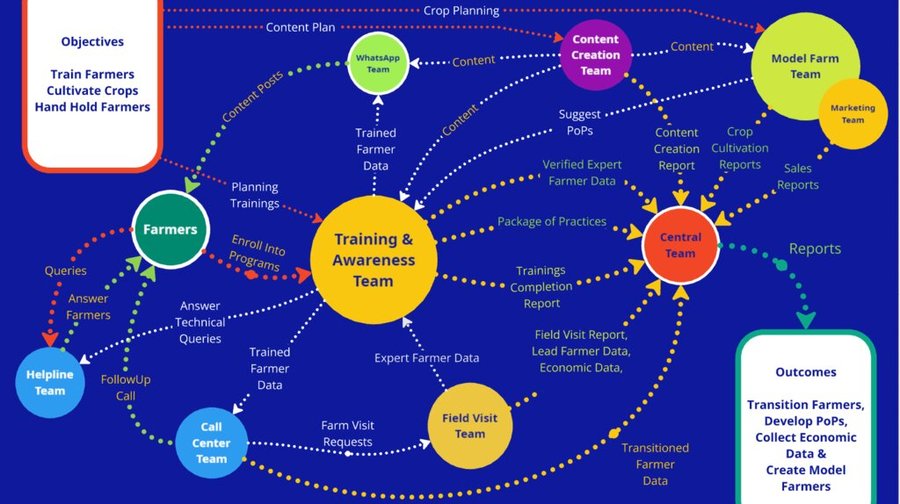
决策是由......做出的
决策是基于
The training covered a wide range of subjects related to regenerative agriculture, including preparation of inputs, crop specific practices for all the major crops and vegetables in the region, value addition of farm produce, livestock management, marketing and sales, a complete knowhow on timber species, seed selection, input preparation and application, biological pest management, harvesting techniques, value addition, and marketing strategies for many timber species.
On-ground farm visit support is provided to choose the right tree species depending on soil type, soil depth and water availability and post plantation support for tree growth and care is provided.
Apart from educating farmers in regenerative agriculture, some of the farmers are also trained to produce and distribute saplings in their own farms providing them another livelihood opportunity, they are provided with buybacks arrangement and performance incentives.
Volunteers under the guidance of agricultural experts, scientists, economists, and agronomists completed the research
Timber saplings are provided to farmers at 90% subsidized rate, just at 4 cents
土地使用者的劳动力为
The training is provided at a bare minimum cost just to ensure their full participation. A regularly updated, free, online knowledge repository of best practices is created for farmers to make use of at any point of time Farmers who are trained in running distribution nurseries are provided incentives on each sale of sapling. There is also an assured buy-back arrangement, guaranteeing a market for the produced saplings Incentive of Rs 125/ sapling from the Government of Karnataka to farmers in the first 3 years for up to 400 saplings per hectare, based on sapling survival rates.
The approach has empowered farmers by providing financial stability. This has also instilled pride in the profession as many were on the verge of quitting.
Soil quality improvements have been evidenced through soil tests, but farmers mainly focus on economic benefits. Efforts are ongoing to collect comprehensive economic data to support evidence-based decision-making. We learnt if ecological changes are to be seen on a scale, then farmers must be involved as they own more than 50% land, hence as an approach we enabled farmers to take up tree plantation in farmlands. Farmers plant trees on their land and take appropriate care ensuring high survival rate of trees.
Due to the simplicity of the approach, one-third of trained farmers have fully transitioned to sustainable practices, and 225,000 farmers have adopted long-duration timber crops after observing guaranteed financial returns.
The farmer-to-farmer learning model has proven to be the most cost-effective and efficient method for spreading farming techniques
Access to financial resources remains limited, as the approach yields long-term benefits, whereas donors often seek short-term results. Donations are frequently short-lived, moving on to other areas of action.
Continuous engagement through social media, WhatsApp, and helplines has kept handholding support robust, increasing farmers' interest and knowledge over time.
Farmers have demonstrated the effectiveness of the approach, gaining recognition from consumers and the government. Government officials have consulted and signed MoUs, acknowledging the significant progress made.
The collaboration between farmers and consumers has strengthened, benefiting both parties and supporting the movement's growth and future establishment as a mainstream practice.
The primary conflict is between policymakers and farmers, many of whom are burdened by defunct policies and debts. Regenerative farmers have seen reduced debt, helping to alleviate these conflicts.
The focus is on the farming community, with farmers working across the state in isolation. No direct efforts have been made to empower other socially disadvantaged groups.
Approximately 25-30% of participants are women, many of whom have shared their success stories publicly. These women are leading the way in demonstrating gender equality in agriculture.
The approach combines ecological and economic benefits, attracting a large number of young people to the training programs.
The approach does not address farmers with land tenure issues, resulting in no direct impact on this area.
Families that have adopted chemical-free farming practices have seen improvements in health, contributing to better food security and nutrition.
The Farmer Producer Organization (FPO) program has improved access to fair markets for both selling produce and purchasing inputs. Farmers are also supported to engage in direct marketing to secure stable prices.
The elimination of chemicals contributes to more sustainable energy use, supporting the movement towards overall sustainability.
Tree-based agriculture has increased water-holding capacity, making farmers more resilient to droughts and floods.
The approach has provided stability of income through short-, medium-, and long-term returns. Vegetables provide year-round income, while value addition training and cost-reduction strategies have benefited many farmers. Income opportunities for 62 farmers running nurseries have opened up and employment of 400 women in Cauvery Calling run 31 nurseries
The approach is taught to farmers over an extended period using a variety of methods and technologies. During the transition, farmers receive comprehensive support, from purchasing inputs, getting subsidized saplings to marketing their produce. Costs are significantly reduced, and soil quality continues to improve, leading to tangible ecological and economic benefits. The movement is gaining momentum, reducing the risk of reverting to unsustainable practices due to peer support and shared success. The younger generation is increasingly interested in sustainable farming, and improvements in health further incentivize farmers to continue these practices, ensuring long-term sustainability without external support.